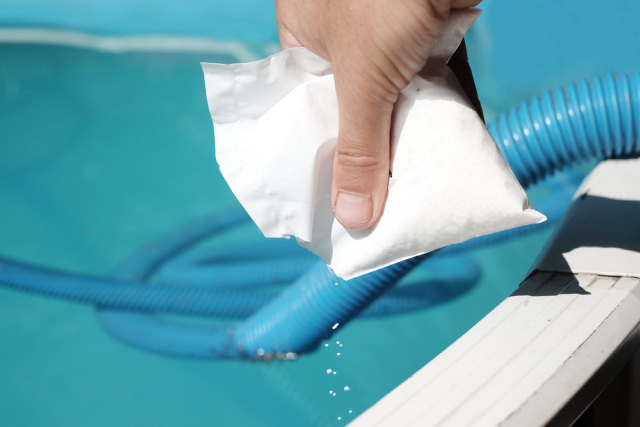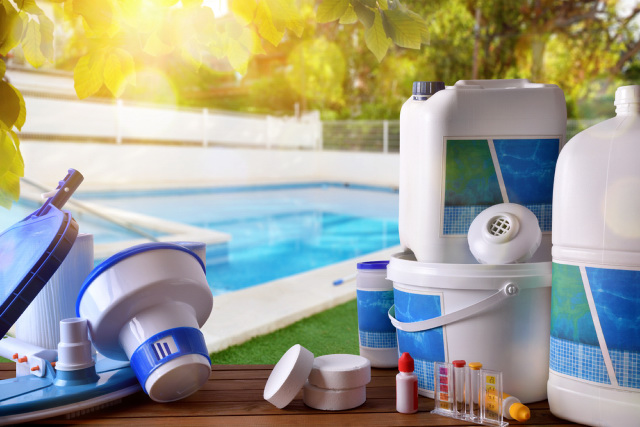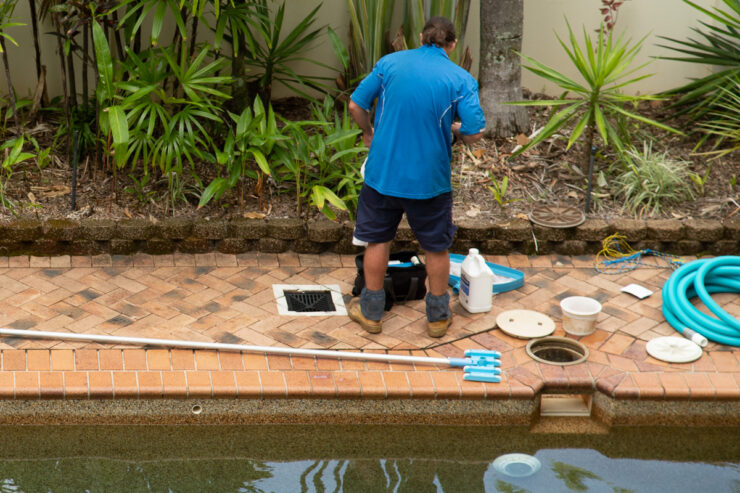Is your pool water making your skin feel itchy and seems to have a strong “chlorine” smell? It’s likely your combined chlorine is too high, and your free chlorine levels are too low. In this article, you will learn how to lower combined chlorine and increase the amount of free chlorine in your pool.

High combined chlorine levels in a swimming pool can be lowered by shocking the pool, using enzymes, installing a UV or ozone system, and reducing sources of ammonia. Additionally, the pool should have a pH of 7.4 – 7.6 and cyanuric acid (stabilizer) levels of 30 – 50 ppm.
Article Contents
How Do You Know Combined Chlorine is Too High?
The first sign that combined chlorine in your pool is too high is the smell of “chlorine.” While most people think they smell chlorine, this isn’t quite right. What you’re smelling is chloramines (combined types of chlorine).
What Are Chloramines?
Chloramines are chemicals that are made up of chlorine and ammonia. They are an oxidant and essentially a by-product of the breakdown of free chlorine, creating combined chlorine.
So this smell can tip you off that combined chlorine is too high and free chlorine is too low.
What is Free Chlorine?
When it comes to chlorine, we have combined chlorine, free chlorine, and total chlorine. Free chlorine is a great sanitizer for your pool water. It becomes “free” when chlorine is added to the pool water and is broken down into hypochlorous acid, then dissolves further and combines with oxygen, creating hypochlorite ions.
The free chlorine does most of the sanitizing in your pool. Both chloramines and free chlorine have important roles, but ensuring they exist at a healthy level is crucial.
The key difference is that free chlorine is the predominant sanitizer, while chloramines do disinfect but are far less effective. If there is a high level of combined chlorine, therefore chloramines, and a low level of free chlorine, you will not have a healthy pool to swim in.
Why is Combined Chlorine Too High and Free Chlorine Low

Reasons why combined chlorine is too high include:
- Excessive bather load and not enough chlorine
- Overload of contaminants
- Cleaning products used near the pool
- Free chlorine levels too low
The levels of combined chlorine can become too high when there is not enough free chlorine in your pool. Essentially, the oxidant demand is greater than what chlorine can handle, so it is harder for the pool to become healthy and sanitized to swim in.
There can then be a lot of contaminants in the pool water; it can have a strong smell and cause skin irritation and even health issues if the problem is not addressed. Common contaminants include body lotions such as sunscreen, urea, sweat, and animal feces.
Should You Swim if Combined Chlorine is High?
You do not want to swim in a pool if the combined chlorine levels are too high. By having low free chlorine and combined chlorine that is too high, the chlorine is not working effectively and is struggling to do its job. Ultimately you want very little, if any, combined chlorine in the water.
Recommended Combined Chlorine Levels
It is recommended that the level of combined chlorine present in your pool water should not be over 0.5 – 1 ppm. Ideally, combined chlorine levels should be 0 ppm.
The recommended amount of free chlorine in your pool water is around 3 ppm (parts per million).
You can calculate the amount of combined chlorine in your pool by subtracting the amount of free chlorine from the amount of total chlorine. You always want to ensure that the amount of free chlorine is higher than that of combined chlorine in your pool.
How To Test Combined Chlorine In Your Pool
Before we fix why combined chlorine might be too high, let’s examine how you measure and test it.
To do this, we need to look at what combined chlorine is. Simply put:
Combined Chlorine (CC) = Total Available Chlorine (TAC) – Free Available Chlorine (FC)
There are a few ways to test the combined chlorine levels in your pool water, but generally, a liquid test kit will be far more accurate than a test strip.
Whichever way you go, your test kit must be capable of testing free and total chlorine.
I recommend using the Taylor K1515A Chlorine Drop Test Kit, which is easy to use and will tell you the combined chlorine level and total level, and then you can work out the free chlorine level. This kit only costs around USD $25 – $35 on Amazon and is a great starter kit.
Or if you want the ultimate pool test kit, get the Taylor K-2006 test kit.
Once you have tested your water, simply subtract the free chlorine from the total chlorine to get the combined chlorine levels.
Depending on the results, make adjustments (usually by adding chlorine) to achieve the recommended chlorine levels. But you may need to balance the pH and cyanuric acid too.
5 Methods to Help Lower Combined Chlorine Levels
Reducing your swimming pool’s combined chlorine levels back into balance can be done; however, know it is not a one size fits all thing. Here are 5 ways to lower combined chlorine levels in your pool water.
1. Shock the Pool to Achieve Breakpoint Chlorination
You can shock the pool with chlorine if the combined chlorine level is too high and the free chlorine levels are low. I would recommend you use Calcium Hypochlorite or Sodium Hypochlorite (liquid chlorine) to shock your pool, as these don’t contain stabilizers.
Shocking your pool is to get your chlorine levels to a breakpoint.
What is Breakpoint Chlorination?
The term “breakpoint chlorination” refers to when an excess of chlorine exceeds the oxidant demand, therefore, sanitization of your pool water can occur.
Simply put, free chlorine is available to keep your pool healthy and eliminate contaminants, which is a good thing!
As a pool owner, you would typically add small amounts of chlorine to sanitize your pool regularly and maintain a chemical balance. The chlorine will work effectively, and the different chlorine levels will be relatively stable and balanced.
However, if you have neglected the maintenance of your pool, or it has been getting a lot of use, and you have high combined chlorine levels, you’ll need to use a high dose of chlorine to achieve a breakpoint.
You will likely need to shock (super chlorinate) your pool or maintain high chlorine levels (around 15 – 30 ppm) for several days if your pool has many contaminants. This will decrease the combined chlorine levels and increase free available chlorine levels.
2. Use Enzymes
Enzymes will help reduce the amount of oxidation that chlorine needs to do by metabolizing carbon-based body products such as sunscreen and deodorants.
3. Use a Secondary Disinfection System
An ultraviolet system (UV) or ozone system can support reducing chloramines and lowering combined chlorine levels. Although this is unlikely to lower combined chlorine on its own, it will help keep it in check in the future.
4. Check Cyanuric Acid Levels
Cyanuric acid (aka stabilizer or CYA) helps prolong free chlorine’s life. But if there is too much in the water, it will reduce the chlorine effectiveness. Ensure your cyanuric acid levels are between 30 – 50 ppm. If not, you can lower it by diluting it – just add some fresh water to the pool.
5. Identify & Reduce Additional Sources of Ammonia
Ammonia will use your chlorine up and form chloramines or combined chlorine. Check if other sources of ammonia are getting into your pool water and aim to decrease this.
Some sources of ammonia may include:
- Pool deck cleaners
- Algaecides
- Garden or lawn products
- Sunscreen, sweat, or urine from swimmers
3 Tips to Prevent High Combined Chlorine Levels

Here are a few tips to help stop your pool’s high combined chlorine levels and low free chlorine levels.
1. Maintain Chlorine Levels
Keep the free chlorine level around 3 ppm consistently to avoid huge fluctuations, which may create high combined chlorine levels in your pool water and reduce the effectiveness of the chlorine. You can do this by testing twice a week and adding chlorine regularly.
Additionally, always ensure the pH level is 7.4 – 7.6 and stabilizer (cyanuric acid) levels are 30-50 ppm.
2. Remove Debris & Filter the Water
Run the pool filter as often as possible (12-14 hrs per day in summer) and skim the pool to collect bugs, sticks, leaves, and other debris in the pool water.
3. Have Pool Rules
If people are using your pool in the summer, make it clear that you do not want anyone peeing, eating, or covering themselves with sunscreen or makeup before hopping into the pool.
At the end of the day, you have to deal with the consequences, which can be frustrating and time-consuming if your chlorine has to work a lot harder to eliminate an influx of contaminants!


